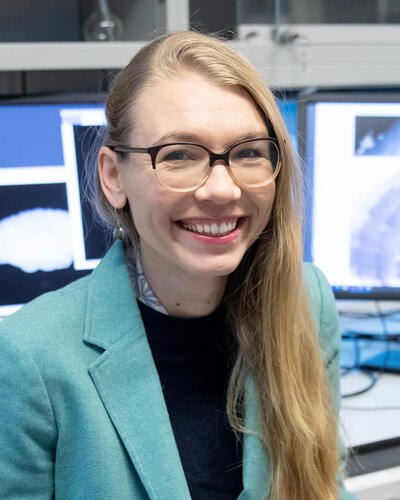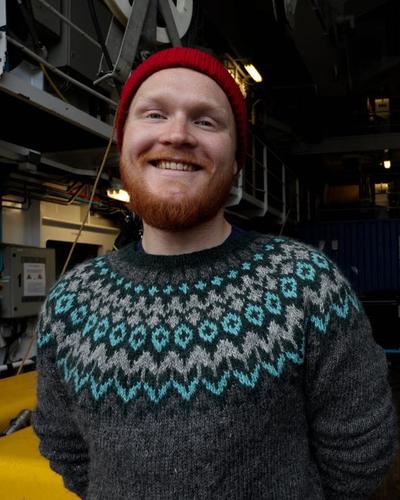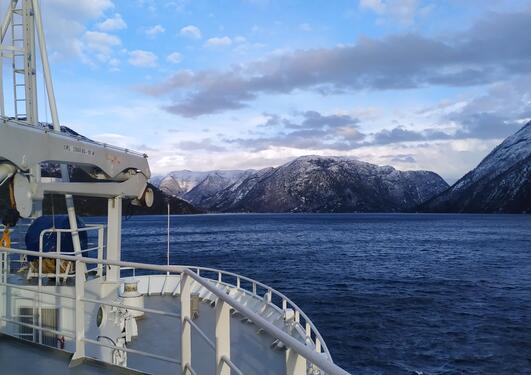Ocean science seminar - Autonomous landers and their applications for deep-sea research
The Fjord and Coastal Ecology research group is pleased to invite all interested in marine ecology, deep-sea communities, and ocean monitoring to join us for a seminar held by Kevin Hardy (Global Ocean Design), Ashley Nicoll (Stony Brook University) and Natalya Gallo (University of Bergen).

Main content
Kevin and Ashley are visiting the University of Bergen as part of the CLIFORD project - CLImate change and sustainability in Norwegian FjORDs. During this hybrid event, our guests will give us three lectures about the monitoring of deep-sea communities, why it is important, and the tools we have at our disposal to carry out this challenging task.
When: Wednesday, 12th of April 2023 (14:00-16:00)
Where: Auditorium B - Allégaten 66 (room number A-112, floor 1) and on Zoom
The lecturers:
Kevin Hardy is the President of Global Ocean Design and is an ocean engineer known for developing cutting-edge technology to probe the ocean’s deepest depths. He holds patents in the field of unmanned ocean landers and led the lander team for James Cameron’s DEEPSEA CHALLENGE Expedition and designed the ocean lander used by the Universidad de Concepcion to dive to the deepest point of the Atacama Trench in Chile in 2018. He previously worked at the Scripps Institution of Oceanography as an engineer and received an honorary Doctor of Science degree from Shanghai Ocean University in 2018.
Global Ocean Design page: GLOBAL OCEAN DESIGN - Home
Ashley Nicoll is a PhD student in marine biology at Stony Brook University and is advised by Michael Frisk and Robert Cerrato. Her PhD work focuses on fish movement ecology in coastal systems off Long Island, New York. She received her M.S. from Scripps Institution of Oceanography in 2021 and her thesis was on the use of small autonomous landers to study the community ecology of nearshore submarine canyons. She has a wealth of field experience including working with small boats, on ships, and scuba diving for research.
Ashley's profile page: Ashley Nicoll | LinkedIn
Natalya Gallo is a postdoctoral researcher at the Department of Biological Sciences at the University of Bergen and is an affiliate of the Bjerknes Centre for Climate Research. Her current research focuses on how oxygen loss and other climate-related stressors affect deep-sea communities in the Norwegian fjords (HypOnFjordFish project). She received her PhD from the Scripps Institution of Oceanography in 2018 and used a small autonomous lander named BEEBE to examine deepwater oxygen variability and seafloor community responses. As part of the CLIFORD project, she is bringing BEEBE to Norway to conduct lander deployments and study seafloor communities in Masfjord.
Natalya's profile page: Natalya Gallo | University of Bergen (uib.no)
Seminar program:
14:15: Introduction
14:20: Kevin hardy (Global Ocean Design) - The state of the art of autonomous landers for deep-sea research
Abstract: The usage of landers for studying the deep sea has a long history dating back to 1938. They were proposed as alternatives to cabled observations from large research ships and identified for their potential to decrease costs and increase deployment lengths associated with deep-sea observations. Landers are autonomous, positively buoyant modular vehicles with either an onboard timer or acoustic release which drop their ballast and float back to the surface with the scientific payload. In this presentation, I will provide an overview of the advances in lander technology in the 20th and 21st centuries and share experiences of developing landers for a variety of scientific projects — from large lander deployments into the deepest trenches in the world to small landers for nearshore applications.
15:00: Ashley Nicoll (Stony Brook University) - Small autonomous landers for studying the community ecology of nearshore submarine canyons
Abstract: Nearshore submarine canyons are unique features that bring the deep sea close to shore, potentially functioning as highways connecting shallow and deep-sea ecosystems. To study their ecology, we developed two autonomous lander systems: a 2-sphere Picolander for exploratory deployments (< 3 days) and a 3-sphere Nanolander for longer deployments (> 1 week). Both landers were outfitted with a camera and lights system and a ZebraTech environmental sensor and collected paired physical and biological time series. Eleven lander deployments were conducted, ranging in length from 1-13 days, and at depths of 90-500 m. In this presentation, I will showcase what we learned about diurnal and depth-related changes in seafloor community diversity and composition in the La Jolla submarine canyon (USA) using lander data.
15:30: Natalya Gallo (University of Bergen, Bjerknes Centre for Climate Research) - Characterizing deepwater oxygen variability and seafloor community responses using an autonomous lander
Abstract: Studies on the impacts of climate change typically focus on changes to mean conditions. However, animals live in temporally variable environments that give rise to different exposure histories that can affect their sensitivities to climate change. Ocean deoxygenation has been observed off California, but how these changes compared to the magnitude of natural O2 variability experienced by seafloor communities at short timescales was previously unknown. We used a 3-sphere Nanolander with a SBE MicroCAT and camera system, to collect high-frequency environmental (O2, T, estimated pH) and seafloor community data at depths between 100 and 400 m off San Diego, California (USA). In this presentation, I will share what we learned about timescales of natural environmental variability and community responses. The lander used for this research is coming to Bergen, and the presentation will end with a brief description of the upcoming planned deployments in Masfjorden to examine community responses to low-oxygen events.

Deployment of the BEEBE lander in California (USA). How many interesting species will it record?
_____________________________________________
If you have any inquiries please get in touch with the seminar organisers.
Follow this link or scan the QR code below for indoor navigation to the seminar room!




